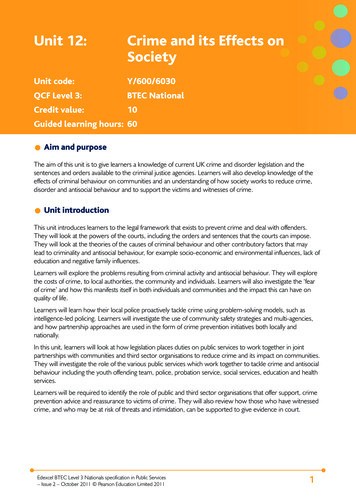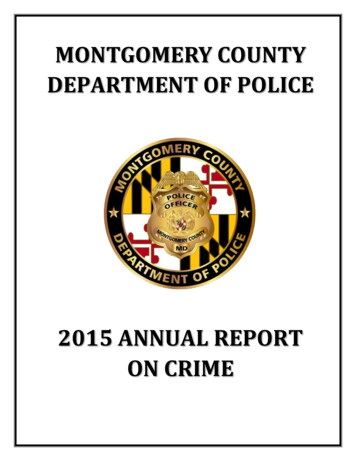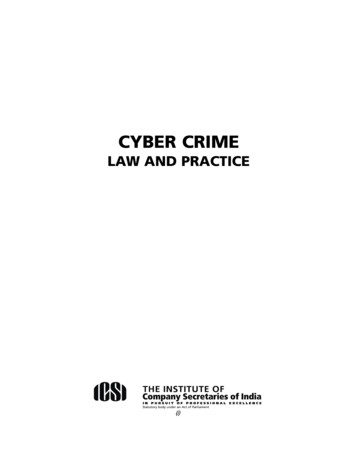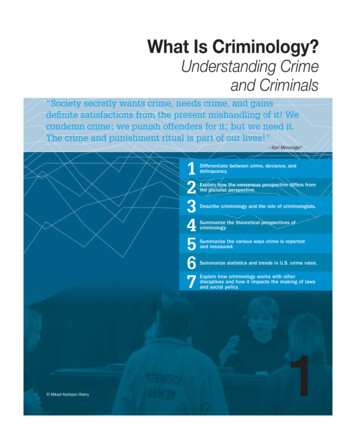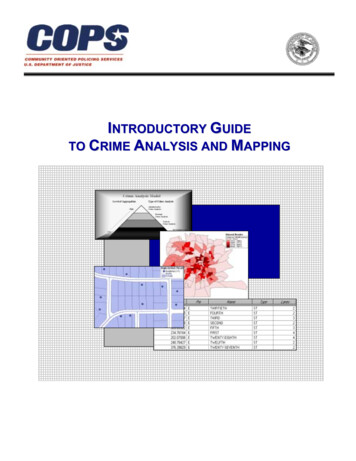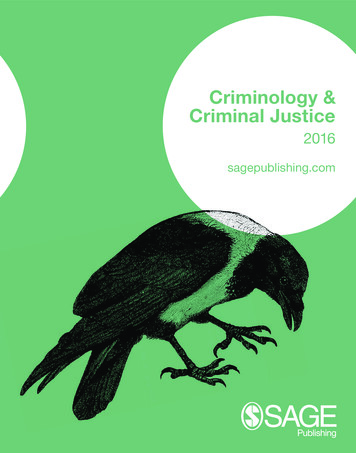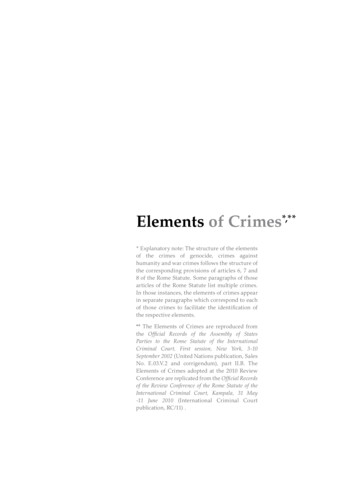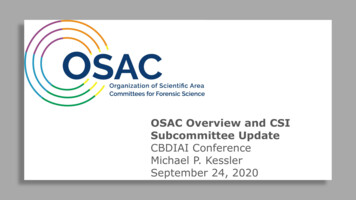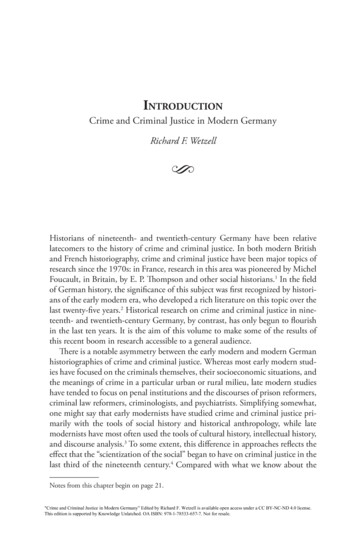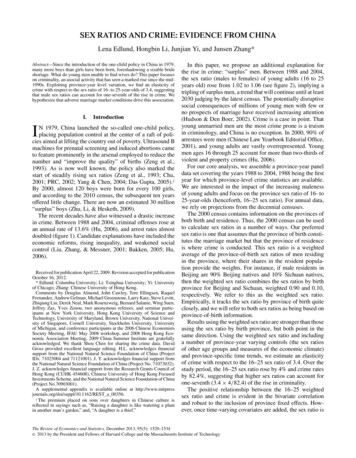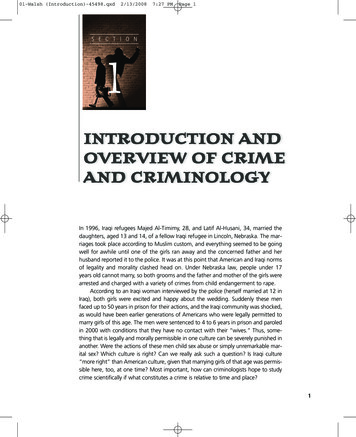
Transcription
01-Walsh (Introduction)-45498.qxd2/13/20087:27 PMPage 1S E C T I O N1INTRODUCTION ANDOVERVIEW OF CRIMEAND CRIMINOLOGYIn 1996, Iraqi refugees Majed Al-Timimy, 28, and Latif Al-Husani, 34, married thedaughters, aged 13 and 14, of a fellow Iraqi refugee in Lincoln, Nebraska. The marriages took place according to Muslim custom, and everything seemed to be goingwell for awhile until one of the girls ran away and the concerned father and herhusband reported it to the police. It was at this point that American and Iraqi normsof legality and morality clashed head on. Under Nebraska law, people under 17years old cannot marry, so both grooms and the father and mother of the girls werearrested and charged with a variety of crimes from child endangerment to rape.According to an Iraqi woman interviewed by the police (herself married at 12 inIraq), both girls were excited and happy about the wedding. Suddenly these menfaced up to 50 years in prison for their actions, and the Iraqi community was shocked,as would have been earlier generations of Americans who were legally permitted tomarry girls of this age. The men were sentenced to 4 to 6 years in prison and paroledin 2000 with conditions that they have no contact with their “wives.” Thus, something that is legally and morally permissible in one culture can be severely punished inanother. Were the actions of these men child sex abuse or simply unremarkable marital sex? Which culture is right? Can we really ask such a question? Is Iraqi culture“more right” than American culture, given that marrying girls of that age was permissible here, too, at one time? Most important, how can criminologists hope to studycrime scientifically if what constitutes a crime is relative to time and place?1
01-Walsh (Introduction)-45498.qxd22/13/20087:27 PMPage 2INTRODUCTION TO CRIMINOLOGYyWhat Is Criminology?Criminology is an interdisciplinary science that gathers and analyzes data on various aspectsof crime and criminal behavior. As with all scientific disciplines, its goal is to understand itssubject matter and to determine how that understanding can benefit humankind. In pursuitof this understanding, criminology asks questions such as the following: Why do crime rates vary from time to time and from culture to culture?Why are some individuals more prone to committing crime than others?Why do crime rates vary across different ages, genders, and racial/ethnic groups?Why are some harmful acts criminalized and not others?What can we do to prevent crime?By a scientific study of crime and criminal behavior we mean that criminologists use thescientific method to try to answer the questions they ask, rather than simply philosophizingabout them. The scientific method is a tool for winnowing truth from error by demandingevidence for one’s conclusions. Evidence is obtained by formulating hypotheses derived fromtheory that are rigorously tested with data. How this is accomplished will be addressed later inthis section, after we discuss the nature of crime.yWhat Is Crime?The term criminal can and has been applied to many types of behavior, some of which nearly allof us have been guilty of at some time in our lives. We can all think of acts that we feel ought tobe criminal but are not, or acts that should not be criminal but are. The list of acts that someoneor another at different times and at different places may consider to be crimes is very large, andonly a few are defined as criminal by the United States law at this time. Despite these difficulties,we need a definition of crime in order to proceed. The most often-quoted definition is that ofPaul Tappan (1947), who defined crime as “an intentional act in violation of the criminal lawcommitted without defense or excuse, and penalized by the state” (p. 100). A crime is thus an actin violation of a criminal law for which a punishment is prescribed; the person committing it musthave intended to do so and must have done so without legally acceptable defense or justification.Tappan’s definition is strictly a legal one that reminds us that the state, and only the state,has the power to define crime. Hypothetically, a society could eradicate crime tomorrowsimply by rescinding all of its criminal statutes. Of course, this would not eliminate the behavior specified by the laws; in fact, the behavior would doubtless increase because the behaviorcould no longer be officially punished. While it is absurd to think that any society would tryto solve its crime problem by eliminating its criminal statutes, legislative bodies are continually revising, adding to, and deleting from their criminal statutes.yCrime as a Moving TargetEvery vice is somewhere and at some time a virtue. There are numerous examples, such as thevignette at the beginning of this chapter, of acts defined as crimes in one country being toleratedand even expected in another. Laws also vary within the same culture from time to time as well
01-Walsh (Introduction)-45498.qxd2/13/20087:27 PMPage 3Section 1 Introduction and Overview of Crime and Criminologyas across different cultures. Until the Harrison Narcotics Act of 1914, there were few legalrestrictions in the United States on the sale, possession, or use of most drugs, including heroinand cocaine. Following the Harrison Act, many drugs became controlled substances, theirpossession became a crime, and a brand new class of criminals was created overnight.Crimes pass out of existence also, even acts that had been considered crimes for centuries.Until the United States Supreme Court invalidated sodomy statutes in Lawrence v. Texas(2003), sodomy was legally punishable in many states. Likewise, burning the American flaghad serious legal consequences until 1989, when the Supreme Court in Texas v. Johnson invalidated anti-flag-burning statutes as unconstitutional. What constitutes a crime, then, can bedefined in and out of existence by the courts or by legislators. As long as human societiesremain diverse and dynamic, there will always be a moving target of activities with the potential for nomination as crimes, as well as illegal activities nominated for decriminalization.If what constitutes crime differs across time and place, how can criminologists hope toagree upon a scientific explanation for crime and criminal behavior? Science is about makinguniversal statements about stable or homogeneous phenomena. Atoms, the gas laws, the lawsof thermodynamics, photosynthesis, and so on are not defined or evaluated differently by scientists around the globe according to local customs or ideological preferences. But the phenomenon we call “crime keeps moving around, and because it does some criminologists havedeclared it impossible to generalize about what is and is not ‘real’ crime” (Hawkins, 1995, p. 41).What these criminologists are saying is that crime is a socially constructed phenomenonthat lacks any “real” objective essence and is defined into existence rather than discovered.At one level, of course, everything is socially constructed; nature does not reveal herself tous sorted into ready-labeled packages; humans must do it for her. Social construction meansnothing more than that humans have perceived a phenomenon, named it, and categorized itaccording to some classificatory rule that makes note of the similarities and differences amongthe things being classified. Most classification schemes are not arbitrary; if they were, wewould not be able to make sense of anything. Categories have empirically meaningful referents and are used to impose order on the diversity of human experience, although argumentsexist about just how coherent that order is.yCrime as a Subcategory of Social HarmsSo, what can we say about crime? How can we conceive of it in ways that at least most peoplewould agree are coherent and correspond with their view of reality? When all is said and done,crime is a subcategory of all harmful acts that range from simple acts like smoking to very serious acts like murder. Harmful acts are thus arrayed on a continuum in terms of the seriousness of the harm involved. Some harmful acts, such as smoking tobacco and drinking toexcess, are not considered anyone’s business other than the actor’s if they take place in privateor even in public if the person creates no annoyance.Socially (as opposed to private) harmful acts are acts deemed to be in need of regulation(health standards, air pollution, etc.), but not by the criminal law except under exceptional circumstance. Private wrongs (such as someone reneging on a contract) are socially harmful, butnot sufficiently so to require the heavy hand of the criminal law. Such wrongs are regulated bythe civil law, in which the wronged party (the plaintiff), rather than the state, initiates legalaction, and the defendant does not risk deprivation of his or her liberty if the plaintiff prevails.3
01-Walsh (Introduction)-45498.qxd42/13/20087:27 PMPage 4INTRODUCTION TO CRIMINOLOGYFurther along the continuum we find a category of harmful acts considered so sociallyharmful that they come under the purview of the coercive power of the criminal justice system. Even here, however, we are still confronted with the problem of human judgment indetermining what goes into this subcategory. But this is true all along the line; smoking wasonce actually considered rather healthy, and air pollution and unhealthy conditions weresimply facts of life about which nothing could be done. Categorization always requires a seriesof human judgments, but that does not render the categorizations arbitrary.The harm wrought by criminal activity exacts a huge financial and emotional price. Theemotional pain and suffering borne by crime victims is obviously impossible to quantify, butmany estimates of the financial harm are available. Most estimates focus on the costs of running the criminal justice system, which includes the salaries and benefits of personnel and themaintenance costs of buildings (offices, jails, prisons, stations) and equipment (vehicles,weapons, uniforms, etc.). Added to these costs are the costs associated with each crime (theaverage cost per incident multiplied by the number of incidents as reported to the police). Allthese costs combined are estimates of the direct costs of crime.The indirect costs of crime must also be considered as part of the burden. These costsinclude all manner of surveillance and security devices, protective devices (guns, alarms, security guards) and insurance costs, medical services, and the lost productivity and taxes of incarcerated individuals. Economist David Anderson (1999) lists a cascade of direct and indirectcosts of crime and concludes that the aggregate burden of crime in the United States (in 1997dollars) is about 1,102 billion, or a per capita burden of 4,118. Crime thus places a hugefinancial burden on everyone’s shoulders, as well as a deep psychological burden on itsspecific victims.yBeyond Social Construction:The Stationary Core CrimesFew people would argue that an act is not arbitrarily categorized or is not seriously harmful ifit is universally condemned. That is, there is a core of offenses defined as wrong at almost alltimes and in almost all cultures. Some of the strongest evidence in support of the stationarycore perspective comes from the International Criminal Police Organization (Interpol)(1992), headquartered in Lyon, France. Interpol serves as a repository for crime statistics fromeach of its 125 member nations. Interpol’s data show that such acts as murder, assault, rape,and theft are considered serious crimes in every country.Criminologists call these universally condemned crimes mala in se (“inherently bad”).Crimes that are time and culture bound are described as mala prohibita (“bad because theyare prohibited”). But how can we be sure that an act is inherently bad? We would say that thelitmus test for determining a mala in se crime is that no one, except under the most bizarreof circumstances, would want to be victimized by it. While millions of people seek to be “victimized” by prostitutes, drug dealers, bookies, or any of a number of other providers of illegal goods and services, no one wants to be murdered, raped, robbed, or have his or herproperty stolen. Being victimized by such actions evokes physiological reactions (anger, helplessness, sadness, depression, a desire for revenge) in all cultures, and would do so even if theacts were not punishable by law or custom. Mala in se crimes engage these emotions notbecause some legislative body has defined them as wrong, but because they hammer at our
01-Walsh (Introduction)-45498.qxd2/13/20087:27 PMPage 5Section 1 Introduction and Overview of Crime and Criminology Photo 1.1Group portrait of a police department liquor squad posing with cases of confiscated alcohol and distillingequipment during Prohibition.deepest primordial instincts. Evolutionary biologists propose that these built-in emotionalmechanisms exist because mala in se crimes threatened the survival and reproductive successof our distant ancestors, and that they function to strongly motivate people to try to preventsuch acts from occurring and punish the perpetrators if they do (Daly & Wilson, 1988;O’Manique, 2003; Walsh, 2000).Figure 1.1 illustrates the relationship of core crimes (mala in se) to acts that have beenarbitrarily defined (mala prohibita) as crimes and all harmful acts that may potentially becriminalized. The Figure is inspired by John Hagan’s (1985) effort to distinguish between“real” crimes and “socially constructed” arbitrary crimes by examining the three highly interrelated concepts of consensus (the degree of public agreement on the seriousness of an act),the severity of penalties attached to an act, and the level of harm attached to an act.yCriminalityPerhaps we can avoid altogether the problem of defining crimes by studying individuals whocommit predatory harmful acts, regardless of the legal status of the acts. Criminologists dothis when they study criminality. Criminality is a clinical or scientific, rather than legal, term,and one that can be defined independently of legal definitions of crimes. Crime is an intentional act of commission or omission contrary to the law; criminality is a property of individuals that signals the willingness to commit those and other harmful acts (Gottfredson &Hirschi, 1990). Criminality is a continuously distributed trait that is a combination of other5
01-Walsh (Introduction)-45498.qxd62/13/20087:27 PMPage 6INTRODUCTION TO CRIMINOLOGYFigure 1.1Mala in Se and Mala Prohibita Crimes as Subsets of All HarmsCore OffensesMala in seAll CrimesMala in se andmala prohibitaAll Social HarmsState regulated butnot by criminal lawAll HarmsMostly private matters;rare state interventionHigh consensus,severe penalties,high level of harmLow/moderate consensus,low/moderate penalties,low to moderate harmHarms outsidethe purview ofthe criminaljustice systemcontinuously distributed traits and that signals the willingness to use force, fraud, or guile todeprive others of their lives, limbs, or property for personal gain. People can use and abuseothers for personal gain regardless of whether the means used have been defined as criminal;it is the propensity to do this that defines criminality, independent of the labeling of an actas a crime or of the person being legally defined as a criminal.Defining criminality as a continuous trait acknowledges that there is no sharp line separating individuals with respect to this trait—it is not a trait that one has or has not. Just abouteveryone at some point in life has committed an act or two in violation of the law. But thatdoesn’t make us all criminals; if it did, the term would become virtually synonymous with theword human! The point is, we are all situated somewhere on the criminality continuum,which ranges from saint to sociopath, just as our heights range from the truly short to the trulytall. Some are so extreme in height that any reasonable person would call them “tall.” Likewise,a small number of individuals have violated so many criminal statutes over such a long periodof time that few would question the appropriateness of calling them “criminals.” Thus, bothheight and criminality can be thought of as existing along a continuum, even though thewords we use often imply that people’s heights and criminal tendencies come in more or lessdiscrete categories (tall/short, criminal/noncriminal). In other words, just as height varies infine gradations, so, too, does involvement in crime.yA Short History of CriminologyCriminology is a young discipline, although humans have probably been theorizing aboutcrime and its causes ever since they first made rules and observed others breaking them. Whatand how people thought about crime and criminals (as well as all other things) in the past was
01-Walsh (Introduction)-45498.qxd2/13/20087:27 PMPage 7Section 1 Introduction and Overview of Crime and Criminology7strongly influenced by the social and intellectual currents of their time. This is no less true ofwhat and how modern professional criminologists think about crime and criminals. In prescientific days, explanations for bad behavior were often of a religious or spiritual nature, suchas demonic possession or the abuse of free will. Because of the legacy of Original Sin, allhuman beings were considered born sinners. The gift of the grace of God kept men andwomen on the straight and narrow, and if they deviated from this line it was because God wasno longer their guide and compass.Other more intellectual types believed that the human character and personality areobservable in physical appearance. Consider Shakespeare’s Julius Caesar’s distrust of Cassiusbecause he “has a lean and hungry look.” Such folk wisdom was systematized by an Italianphysician named Giambattista della Porta, who developed a theory of human personalitycalled physiognomy in 1558. Porta claimed that the study of physical appearance, particularlyof the face, could reveal much about a person’s personality and character. Thieves, forinstance, were said to have large lips and sharp vision.Porta was writing during a historical period known asthe Renaissance, a period between approximately 1450and 1600, which saw a change in thinking from the pureGod-centered supernaturalism and relative barbarism ofthe Middle Ages to more human-centered naturalism.Renaissance means “rebirth” and refers to the rediscoveryof the thinking traditions of the ancient Greeks. Thesciences (primitive as they were) and arts were becomingimportant, the printing press was invented, andChristopher Columbus “discovered” America during thisperiod. In short, the Renaissance began to move humanthinking away from the absolute authority of receivedopinion and toward a way that would eventually lead tothe modern scientific method.Another major demarcation in the emergence ofthe modern world was the Enlightenment, or Age ofReason. The Enlightenment was the period approximatelybetween 1650 and 1800. It might be said that theRenaissance provided a key to the human mind and the Photo 1.2 Charles Darwin (1809–1882)Enlightenment opened the door. Whereas the Renaissanceheavily influenced biological positivism in criminology.is associated with advances in art, literature, music, andphilosophy, the Enlightenment is associated with advances in mathematics, science, and thedignity and worth of the individual as exemplified by a concern for human rights. This concern led to reforms in criminal justice systems throughout Europe, a process given a majorpush by Cesare Beccaria’s work On Crimes and Punishments, which ushered in the so-calledclassical school. The classical school emphasized human rationality and free will in its explanations for criminal behavior. Beccaria and other classical thinkers will be discussed at length inSection 3.Modern criminology really began to take shape with the increasing faith among intellectuals that science could provide answers for everything. These individuals witnessed theharnessing of the forces of nature to build and operate the great machines and mechanismsthat drove the Industrial Revolution. They also witnessed the strides made in biology after
01-Walsh (Introduction)-45498.qxd82/13/20087:27 PMPage 8INTRODUCTION TO CRIMINOLOGYCharles Darwin’s works on the evolution of species. Criminology saw the beginning of the socalled positivist school during this period. Theories of character, such as Franz Josef Gall’s system of phrenology—assessing character from physical features of the skull—abounded. Thebasic idea behind phrenology was that cognitive functions are localized in the brain, and thatthe parts regulating the most dominant functions were bigger than parts regulating the lessdominant ones. Criminals were said to have large protuberances in parts of the brain thoughtto regulate craftiness, brutishness, moral insensibility, and so on, and small bumps in such“localities” as intelligence, honor, and piety.The biggest impact during this period, however, was made by Cesare Lombroso’s theoryof atavism, or the born criminal. Criminologists from this point on were obsessed with measuring, sorting, and sifting all kinds of data (mostly physical) about criminal behavior. Themain stumbling block to criminological advancement during this period was the inadequacyof its research. The intricacies of scientifically valid research design and measurement werenot appreciated, and statistical techniques were truly primitive by today’s standards. The earlypositivist thinkers will be discussed at length in Section 3.The so-called Progressive Era (about 1890 to 1920) ushered in new social ideologies andnew ways of thinking about crime. The era was one of liberal efforts to bring about socialreform as unions, women, and other disadvantaged groups struggled for recognition. Criminologylargely turned away from what was disparagingly termed “biological determinism,” whichimplied that nothing could be done to reform criminals, to cultural determinism. If behavioris caused by what people experience in their environments, so the optimistic argument went,then we can change their behavior by changing their environment. It was during this periodthat sociology became the disciplinary home of criminology. Criminology became less interested in why individuals commit crime from biological or psychological points of view andmore concerned with aggregate level (social structures, neighborhoods, subcultures, etc.) data.It was during this period that the so-called structural theories of crime, such as the Chicagoschool of social ecology, were formulated. Anomie strain theory was another structural/cultural theory that emerged somewhat later (1938). This theory was doubtless influencedstrongly by the American experience of the Great Depression and of the exclusion of blacksfrom many areas of American society.The period from the 1950s through the early 1970s saw considerable dissatisfaction withthe strong structural approach, which many viewed as proceeding as if individuals werealmost irrelevant to explaining criminal behavior. Criminological theory moved toward integrating psychology and sociology during this period and strongly emphasized the importanceof socialization. Control theories were highly popular at this time, as was labeling theory;these are addressed in Section 5.Because the latter part of this period was a time of great tumult in the United States (theanti-war, civil rights, women’s, and gay rights movements), it also saw the emergence of several theories, such as conflict theory, that were highly critical of American society. These theories extended to earlier works of Marxist criminologists, who tended to believe that the onlyreal cause of crime was capitalism. These theories provided little new in terms of our understanding of “street” criminal behavior, but they did spark an interest in white-collar crime andhow laws were made by the powerful and applied against the powerless. These theories areaddressed in Section 6.Perhaps because of a new conservative mood in the United States, theories with the classical taste for free will and rationality (albeit modified) embedded in them reemerged in the
01-Walsh (Introduction)-45498.qxd2/13/20087:27 PMPage 9Section 1 Introduction and Overview of Crime and Criminology1980s. These were rational choice, deterrence, and routine activities theories, all of which hadstrong implications for criminal justice policy. These are discussed in Section 3.In the late 1990s and early 2000s, we witnessed a resurgence of biosocial theories. Thesetheories view all behavior as the result of various biological factors interacting with each otherand with the past and present environments of the actors involved. Biosocial theories havebeen on the periphery of criminology since its beginning but have been hampered by perceptions of them as driven by an illiberal agenda and by their inability to “get inside” the mysteries of heredity and the workings of the brain. The truly spectacular advances in the observationaltechniques (brain scan methods, 10 cheek swabs to test DNA, etc.) in the genomic and neurosciences over the past two decades have made these things less of a mystery today, and socialscientists are increasingly realizing that there is nothing illiberal about recognizing the biologyof human nature.No science advances without the technology at its disposal to plumb its depths. Forinstance, the existence of atoms was first proposed by Greek philosophers more than 2,500years ago. This was dismissed as merely philosophical speculation until the early 19th century,when English chemist John Dalton proposed his atomic theory of chemistry, which assertedthat all chemical reactions are the rearrangements of atoms. Dalton was heavily criticized bychemists who wanted a “pure” chemistry uncontaminated by physics. Yet chemists everywheresoon adopted the idea of atoms, but still debated whether they were an actual physical realityor just a useful concept. Using scanning tunneling microscopes, today we can see individualatoms, and the argument has been put to rest.Criminologists are in a position similar to that of chemists 100 years ago. The concepts,methods, and measuring devices available to geneticists, neuroscientists, endocrinologists, andother biological scientists may do for the progress of criminology what physics did for chemistry, what chemistry did for biology, and what biology is increasingly doing for psychology.Exceptionally ambitious longitudinal studies carried out over decades in concert with medicaland biological scientists, such as the Dunedin Multidisciplinary Health and Development Study(Moffitt, 1993), the National Longitudinal Study of Adolescent Health Study (Udry, 2003), andthe National Youth Survey (Menard & Mihalic, 2001), are able to gather a wealth of genetic, neurological, and physiological data. Such studies are being conducted with increasing frequency.Integrating these hard science disciplines into criminology will no more rob it of its autonomythan physics robbed chemistry or chemistry robbed biology. On the contrary, physics made possible huge advances in chemistry, and chemistry did the same for biology. These advances wouldnot have happened had scientists maintained their call for the “purity” of their disciplines.yThe Role of Theory in CriminologyWhen an FBI agent asked the depression-era bank robber Willie Sutton why he robbed banks,Sutton replied, “Because that’s where the money is.” In his own way, Sutton was offering atheory explaining the behavior of bank robbers. Behind his witty answer is a model of a kindof person who has learned how to take advantage of opportunities provided by convenienttargets flush with a valued commodity. Thus, if we put a certain kind of personality and learning together with opportunity and coveted resources, we get bank robbery. This is what theorymaking is all about: trying to grasp how all the known correlates of a phenomenon are linkedtogether in noncoincidental ways to produce an effect.9
01-Walsh (Introduction)-45498.qxd102/13/20087:27 PMPage 10INTRODUCTION TO CRIMINOLOGYJust as medical scientists want to find out what causes disease, criminologists are interested in finding factors that cause crime and criminality. As is the case with disease, there area variety of risk factors to be considered when searching for causes of criminal behavior. Thefirst step in detected causes is to discover correlates, which are factors that are related to thephenomenon of interest. To discover whether two factors are related, we must see whetherthey vary together; that is, if one variable goes up or down, the other goes up or down as well.Establishing causality requires much more than simply establishing a correlation. Takegender, the most thoroughly documented correlate of criminal behavior ever identified.Literally thousands of studies throughout the world, including European studies going backfive or six centuries, have consistently reported strong gender differences in all sorts of antisocial behavior, including crime, and the more serious the crime the stronger that differenceis. All studies are unanimous in indicating that males are more criminal than females.Establishing why gender is such a strong correlate of crime is the real challenge, as it is withany other correlate. Trying to establish causes is the business of theory.What Is Theory?A theory is a set of logically interconnected propositions explaining how phenomena arerelated and from which a number of hypotheses can be derived and tested. Theories shouldprovide coherent explanations of the phenomena they address, they should correspond withthe relevant empirical facts, and they should provide practical guidance for researchers looking for further facts. This guidance takes the form of a series of statements that can be logically deduced from the assertions of the theory.
AND CRIMINOLOGY 1 SECTION 1 In 1996, Iraqi refugees Majed Al-Timimy, 28, and Latif Al-Husani, 34, married the daughters, aged 13 and 14, of a fellow Iraqi refugee in Lincoln, Nebraska. The mar-riages took place according to Muslim custom, and everything seemed to be going well for awhile unt
